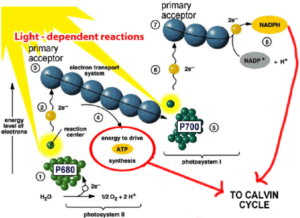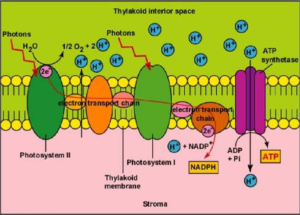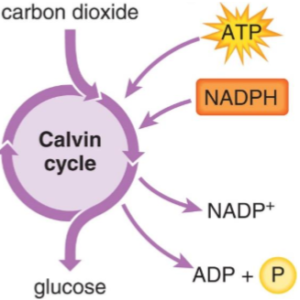The light dependent reaction of photosynthesis involves the capture of light whose energy is used for two purposes:
- To add an inorganic phosphate molecule to ADP thereby making ATP
- To split water by the process of photolysis, into H+ ions and OH- ions
The reaction needs light energy.
It takes place in the thylakoid of the chloroplasts.
The light dependent reaction is useful for making three things:
1. Making ATP from ADP and inorganic phosphate
2. Making reduced NADP from NADP
3. Splitting water into protons, electrons and oxygen
The Making of ATP
1. When a chlorophyll molecule absorbs light energy, it excites the electrons, raising them to higher energy level
2. The electrons become so energetic that they leave the chlorophyll molecule altogether
3. The electrons that leave the chlorophyll are taken up by a molecule called an electron carrier
4. Having lost a pair of electrons, the chlorophyll molecule has been oxidised
5. The electron carrier, which has gained electrons, has been reduced
6. The electrons are now passed along a number of electron carriers in a series of oxidationreduction reactions
7. These electron carriers form a transfer chain that is located in the membranes of the thylakoids
8. Each new carrier chain is at a slightly higher energy level than the previous one in the chain, and so the electrons lose energy at each stage
9. This energy is used to combine an inorganic phosphate molecule with an ADP molecule in order to make ATP
Photolysis of Water
1. The loss of electrons when light strikes a chlorophyll molecule leaves it short of electron
2. If the chlorophyll molecule is to continue absorbing light energy, these electrons must be replaced
3. The replacement electrons are provided from water molecules that are split using light energy
4. This photolysis of water also yields hydrogen ions
5. These hydrogen ions are taken up by an electron carrier called NADP
6. On taking up the hydrogen ions, the NADP becomes reduced
7. The reduced NADP then enters the light-independent reaction along with the electrons from the chlorophyll molecules
8. The reduced NADP is important because it is a further potential source of chemical energy to the plant
9. The oxygen by-product from the photolysis of water is either used in respiration or diffuses out of the leaf as a waste product of photosynthesis
1. Light energy hits photosystem 2 This light energy excites the electrons and causes the chlorophyll to lose electrons These electrons must be replaced Light energy also causes water to split into protons, electrons and oxygen The electrons from photolysis are used to replace the electrons lost from the chlorophyll
2. The excited electron that has come from the chlorophyll has a raised energy level The electron is captured by an electron acceptor and enters an electron chain
3. The electron enters an electron chain where it passes through a series of redox reactions It’s energy level begins to fall The electron carriers are located in the membranes of the thylakoids
4. The energy lost from the electrons as they pass down the electron carrier is used to produce ATP ADP is combined with Pi Energy is required for this process This ATP synthesis is called photophosphorylation The ATP is then used as a source of energy in the Calvin Cycle
5. A second chlorophyll molecule (photosystem 2) also loses an electron when it receives light energy The electron from the transport chain is used to replace this lost electron
6. The electron lost from the photosystem 1 gains energy and is received by an electron acceptor
7. The electron enters a second electron chain
8. At the end of the second electron chain, an enzyme called NADP+ reductase transfers the electrons to NADP+ A proton from photolysis is added to NADP+ Reduced NADP is produced Reduced NADP is also used along with ATP as a source of chemical energy It enters the Calvin cycle
Chemiosmosis is the name of the process where the movement of H+ ions across a membrane generates ATP – this also occurs in respiration.
The excited electrons lose energy as they move along the electron transport chain.
This energy is used to transport protons into the thylakoid so that the thylakoid has a higher concentration of protons than the stroma.
This forms a proton gradient across the membrane.
Protons move down their concentration gradient, into the stroma via an enzyme ATP synthase.
The energy from this movement combines ADP and Pi to form ATP.
The products of the light-dependent reaction of photosynthesis, ATP and reduced NADP are used to reduce carbon dioxide in the second stage of photosynthesis.
The light-independent reaction takes place in the stroma of the chloroplasts.
The reaction is also called the Calvin cycle.
1. Carbon dioxide from the atmosphere diffuses into the leaf through stomata and diffuses into the stomata and dissolves in water around the walls of the mesophyll cells It then diffuses through the plasma membrane, cytoplasm and chloroplast membranes into the stroma of the chloroplast
2. In the stroma, carbon dioxide combines with the five carbon compound ribulose biphosphate RuBP using an enzyme
3. The combination of carbon dioxide and RuBP produces a 6-carbon compound which is unstable and breaks down into two molecules of the 3-carbon compound glycerate 3-phosphate GP
4. ATP and reduced NADP from the light dependent reaction are used to reduce the activated GP to triose phosphate TP
5. The NADP is re-formed and goes back to the light dependent reaction to be reduced again by adding more hydrogen
6. Some triose phosphate molecules are converted to useful organic substances such as glucose
7. Most triose phosphate molecules are used to regenerate RuBP using ATP produced from the lightdependent reaction
Products of the Calvin Cycle
The Calvin cycle is the starting point for making all the organic substance a plant needs.
Triose phosphate TP and glycerate 3-phosphate GP molecules are used to make carbohydrates, lipids and proteins.
Carbohydrates
made by joining two triose phosphate molecules
Lipids
made using glycerol and fatty acids
Proteins
amino acids joined together



